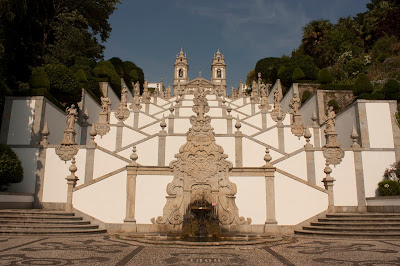June 2017
Before leaving Porto, we first sampled the famous Pastel de nata. It's a very eggy mini custard tart, and sort of reminds me of overdone french toast, somehow in a good way. There's a popularity of eggy custard in many desserts in Portugal which I thought was interesting (though often not to my liking). Supposedly, in medieval times nuns used egg whites to starch their habits, and then had to find a use for all those unused egg yolks; hello many eggy desserts. (In reality, they probably just had too much time on their hands, and many eggs. If bored, bake?)
Eggs were also used as a currency by the poor, which may also explain their egg-treme popularity. (Or maybe the Portuguese just really really like eggs?)
Penha
Our first location out of Porto, the views are amazing and the landscape dramatic, with forests and huge boulders covered in moss and ferns, not unlike something from Middle Earth. It's a scenic drive, and worth going to the top to see the church. It was so great I forgot to take photos, so you will just have to go there yourself!
Bom Jesus do Monte
Another worthy stop, I found this name hilarious, and the views spectacular. It was free which is another bonus, and surprisingly quiet. Maybe other tourists don't like bom jesus, but we thought it was the bomb. Heh.
Guimaraes
This was one of my absolute favourite places in all of Portugal, a medieval town with beautiful architecture, and a festival going on when we arrived! This was the capital of Portugal in the 12th century, and it is commonly said that this is where Portugal was 'born'.
The festival 'Fiera Alfonsina', is a four day event occurring in June, and probably helped me fall in love with the town, considering the atmosphere it gave it. Everyone is dressed in medieval garb, there's stalls selling food, sword fights, music...the town is transformed. My favourite thing was that it wasn't just people walking around, they were acting out little scenes, like women washing their clothes, prostitutes talking to soldiers, and beggars getting shooed away!
We picked up a local specialty as we left called Toucinho do céu, an almond cake with variations across Portugal, but famous from this town in particular. Amusingly, it translates to Bacon from Heaven, a reference to when it used to be made with a dash of pork fat (nowadays its made with a ridiculous number of eggs instead. No really, sometimes up to 20! I told you they were egg-static for eggs).
Citania de Briteiros
This archaeological site holds the remains of an Iron Age hill fort, with charming round houses. The site is a lot bigger than I expected, and you could spend ages wandering around if you were so inclined. Interestingly, its history of excavation is also long, dating back to 1874, with on-going digs until 2006.
Peneda Geres National Park
We decided to head south, to take a break from towns, and make for the beautiful nature instead. Armed with camping supplies from trusty Decathlon, we drove into the huge national park, which is also Portugal's only national park!
We found a ruined castle and climbed to the top. I became momentarily lost on the way back, and realized how terrible my sense of direction was, and my non-existent survival skills. Luckily we then found the car and all was well.
The regional park was amazingly scenic, full of wild goats and horses, and definitely requiring walking shoes and picnics. However we soon discovered supermarkets are very far and few between, so best to bring supplies with you if possible! We ended up having to eat melon filled with port for lunch, because we didn't have anything else to eat. What a shame. *Hic*
Santuário da Senhora da Peneda
This mouthful of a name was an impressively large religious complex, full of interesting architecture and much too enormous for the tiny town around it. (And by around I mean off on one side, because it really was that small). One TripAdvisor review simply said 'very fancy stairway architecture', which, well, I can't really argue with.
Lindoso
A peculiarity of this area were stone granaries, that at first I thought were creepy tombs, because of the crosses. They, and a castle were the highlight of this little town. Known as Espigueiros, these granaries were mainly used in the 18th and 19th centuries to store corn. They were built off the ground to keep the food safe from rats, and some are still in use today.









No comments:
Post a Comment